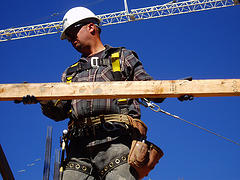

Photo by Payton Chung is licensed under CC BY 2.0
The numbers aren’t surprising because we’ve been hearing them for years.
Texas adds about 400,000 people a year to its population, according to the U.S. Census Bureau. That makes it the fastest-growing state in the nation. Six Texas cities – Austin, Houston, San Antonio, Dallas, Fort Worth and El Paso – rank among the nation’s top 20 fastest-growing large metro areas. Half of the top 10 fastest-growing cities with a population of 100,000 or more, and four of the top five, lie within Texas.
There are reasons for this. Texas is a business-friendly state with a consistent, predictable climate and many natural resources, and that results in an abundance of jobs. The growth, however, puts major strain on the state’s infrastructure and it creates critical needs that are difficult to meet. One result has been a significant housing crunch, especially affordable housing.
Median home prices in cities like Austin, Houston, Dallas and San Antonio didn’t suffer during the recession like those in most other Sun Belt states. And, the cost of these homes has risen since the economic downturn. Cities and communities located outside large cities in Texas have been affected almost as much. New suburban homes in many parts of the state start at $300,000 or more. Home ownership is usually cheaper than renting. Many individuals and families struggle to find a place to live.
City and county public officials are scrambling to alleviate the problem. They want solutions so that their region is not left out. They definitely covet the benefits of growth.
Some cities have passed affordable housing regulations designed to enable families of different income levels to live together in desirable urban neighborhoods. Austin, for instance, created a community land trust that enables an interested party to buy a home in an attractive neighborhood that, without the program, might be unattainable. The program works like this – the family purchases a house but leases the land from the city. That makes the dwelling affordable. Income levels are staggered according to the size of a family. For instance, a family of four making less than $61,050 a year would be eligible for the program. In one East Austin neighborhood, the city used federal grant money to renovate older homes and construct new ones on city-owned land. New homes in the neighborhood start at $330,000, but houses in the program sell for between $90,000 and $115,000.
In Dallas, the Neighborhood Plus program requires developers who benefit from public money to include affordable housing in all new plans. This mandate was not well received by developers and council members are now reevaluating the plan. They hope to find a way to take input and work with the real estate community, but it appears clear that mandates will be upheld.
It’s not an easy problem to solve and there won’t be simple or quick solutions. The issue isn’t going away and the state recently lost a ruling that will have significant impact. The U.S. Supreme Court ruled against the Texas Department of Housing and Community Affairs (TDHCA) in a June affordable housing case. It ruled in favor of Inclusive Communities Project, a Dallas-based advocacy group which argued that the TDHCA incentive program packed low-cost housing into poor neighborhoods rather than integrating families into middle-class neighborhoods. The effects of the ruling are yet to be fully determined, but one thing is certain – public entities will be ever vigilant in how they implement affordable housing regulations and policies in the future.
Strategic Partnerships will be following new developments on this story so be sure to follow Mary Scott Nabers on Facebook and Twitter for continual updates!
